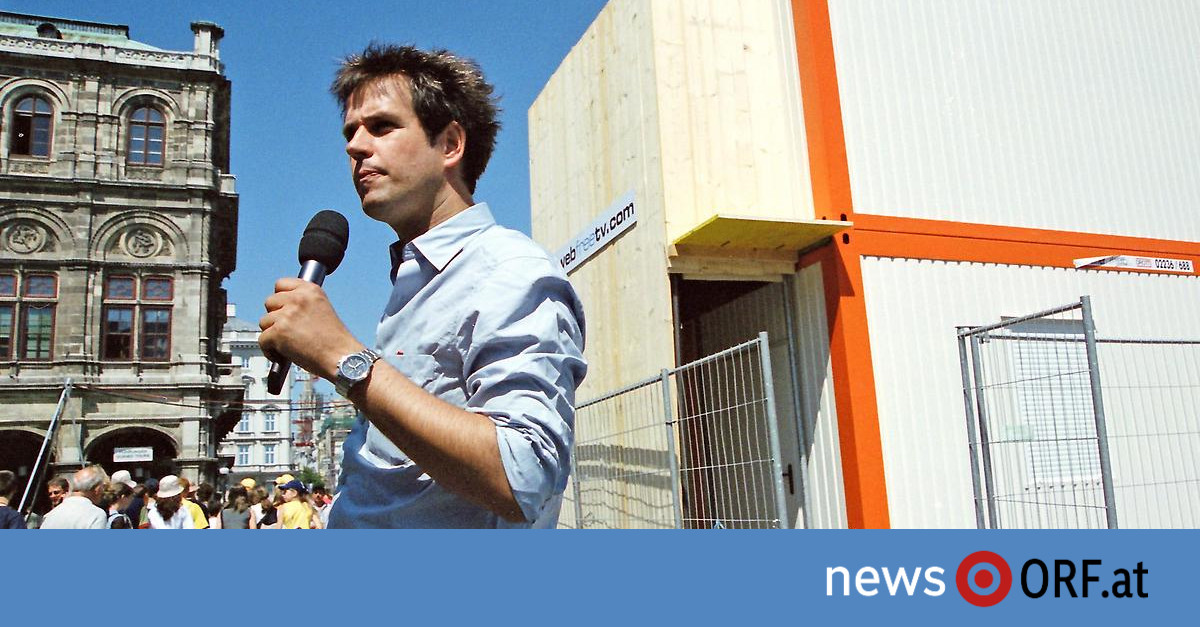In 1997 he was arrested at documenta X because he was walking around with a sign that read “Kill Helmut Kohl”. In 1998 he founded the party “Chance 2000” and staged his election campaign as “Wahlkampfkreis ’98” in circus uniform in Bayreuth the “Parsifal”: Schlingensief was an extremely versatile artist who always saw himself as a filmmaker.
The film was his first love. The first film he received is a child’s recording, seven minutes of amateur footage of a child not even eight years old from the Catholic petty-bourgeois milieu, which the celebrated artist described as formative and important. In “My First Film” you see children in shaky Super 8 images, the voiceover – probably Schlingensief’s child’s voice – announces a funeral, children carry flags in a kind of parade. Schlingensief said of this film that he “shot the first resistance film in 68 when the others demonstrated”.
The eternal director
Reactionary thinking and fascism were two themes that Schlingensief dealt with throughout his work, for example in his Germany trilogy (“100 Years of Adolf Hitler”, 1989, “The German Chainsaw Massacre”, 1990 and “Terror 2000”, 1992) who made his breakthrough. Even in his performative and theatrical works, the medium of film remained dominant for the artistic approach.
Claus Philipp, a former culture journalist at “Standard”, worked closely with Schlingensief on several projects. In an interview with ORF.at he said that Schlingensief had filmed continuously during his theater work and productions: “The act of turning was a kind of performance for him.” The performative, questioning and breaking modes of representation is a possible key to understanding Schlingensiefs Plant.
Politics and communication
This is particularly evident in his works, which clearly transcended the setting of film and theater and played in the political sphere. In 1998, as part of the election campaign of his party “Chance 2000”, he asked six million unemployed people to go swimming in Lake Wolfgang at the same time. As a result, the water level should be raised by two meters and the domicile in which the incumbent German Chancellor Helmut Kohl was vacationing should be flooded.
Of course, only a few swimmers took part in the action and what was left were teasing interviews with Schlingensief, in which it was never clear whether he was serious about what he said and did or withdrew to a theatrical level. When he was invited to the Wiener Festwochen in 2000, a media scandal broke out. His project “Ausländer raus!” Borrowed from the popular TV show “Big Brother” at the time, in which the audience could choose one of the participants every week.
Schlingensief set up a container in front of the State Opera in which several refugees were supposed to live; the audience could select one of the container occupants every day. In this case, “dialing out” meant referring to the country. In addition, the container was decorated with xenophobic posters of the FPÖ, FPÖ flags and a banner with the slogan of the SS, “Our honor means loyalty”, and Schlingensief shouted inflammatory passages from Jörg Haider’s speeches into the megaphone.
The scandal that boiled up at the latest when demonstrators of the Thursday demonstrations, which were held weekly against the coalition of the ÖVP and FPÖ, occupied the container, reached enormous proportions. It was not until the cast did most of the onlookers realize that the refugees were real, not embodied by actors, as many had assumed.
Schlingensief as a pioneer
In retrospect, it all seems well-planned and choreographed, but Philipp told ORF.at that the escalation of the project happened due to audience reactions and that Schlingensief only choreographed from day to day. That important artists such as Elfriede Jelinek and Paulus Manker spent a day with the refugees came about spontaneously, says Philipp. “That was still an action before Facebook,” he pointed out, “if something was said at the time, it was only reported seven hours later and corrected ten hours later.” Schlingensief always sought communication with the audience and understood how important it was whose reaction is, so Philipp.

To a certain extent, Schlingensief created the space for theatrical political forms for the next few years. Be it the election campaign of the former editor-in-chief of the satirical magazine “Titanic”, who has been a member of the European Parliament with his project “The Party” since 2004, or the actions of the “Center for Political Beauty”, which are also within the framework defined by Schlingensief act as well as the artistic and media interventions in Austrian domestic politics by Jan Böhmermann and the political theater Milo Raus.

–
Memory of an exceptional artist
Ten years after Schlingensief’s early death from cancer, the exceptional artist will be remembered intensely in 2020. Together with the festival director Eva Sangiorgi, Philipp curated a retrospective on Schlingensief’s work called “Say Goodbye to the Story” for the 2020 Viennale. In addition to an overview of the cinematic work, new material from the estate will be presented. The Schlingensief documentary “Schlingensief – Screaming into Silence” by Bettina Böhler, presented at the Berlinale, will celebrate its Austrian premiere in this context.
“An essential part of the retrospective will be material that has not yet been seen outside of the theatrical or art installation context or in this design”, said curator Philipp ORF.at. Schlingensief’s widow Aino Laberenz was significantly involved in the project. She also acts as the editor of a new publication on the tenth anniversary of Schlingensief’s death, a collection of interviews he has given since 1993. In it you can see how much Schlingensief always remained a director, also when dealing with interlocutors and the public.
–


